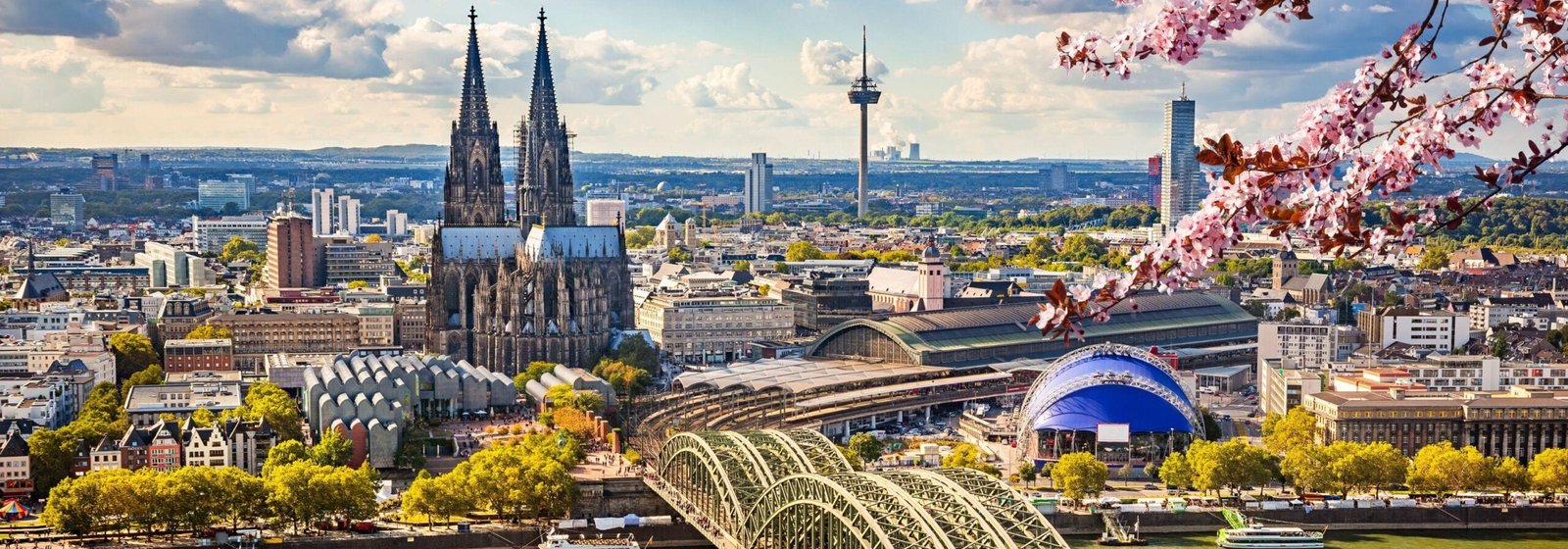Cologne Cathedral Germany’s Gothic Masterpiece and Iconic Landmark 1. Introduction to Cologne Cathedral The Cologne Cathedral in Germany is a breathtaking Gothic masterpiece, admired for its towering spires and intricate details. As one of Europe’s most visited landmarks, it draws millions of travelers who marvel at its grandeur and historical significance. 2. Historical Significance Construction of the Cologne Cathedral began in 1248 and spanned over six centuries, finally being completed in 1880. It was built to house the relics of the Three Kings and stands today as a symbol of faith, endurance, and architectural brilliance. 3. Architectural Marvel of Cologne Cathedral Renowned for its twin spires reaching 157 meters, the Cologne Cathedral is one of the tallest churches in the world. Its stained glass windows, intricate carvings, and soaring arches showcase the pinnacle of Gothic architecture, making it a timeless treasure. 4. UNESCO World Heritage Status Recognized by UNESCO in 1996, Cologne Cathedral is celebrated for its cultural and historical value. It stands as a beacon of medieval artistry and a testament to Germany’s rich heritage. 5. Visitor Information Open year-round, visitors can explore its interiors, climb to the observation platform, and witness panoramic views of Cologne city. 6. Best Time to Visit Spring and autumn offer the most pleasant climate, with fewer crowds compared to peak summer. 7. How to Reach Cologne Cathedral Located in the heart of Cologne, it’s easily accessible by train, tram, or bus. The main station is just a few steps away from the cathedral’s entrance Introduction to Cologne Cathedral The Cologne Cathedral (Kölner Dom) is one of the most magnificent architectural achievements in the world and a crown jewel of Germany’s cultural heritage. Rising majestically above the city of Cologne, this Gothic masterpiece has captured the imagination of travelers, architects, and historians for centuries. Its towering spires, intricate stonework, and awe inspiring stained glass windows create an unmistakable silhouette that dominates the skyline, making it one of the most recognizable landmarks in Europe. Construction of the cathedral began in 1248, inspired by the medieval ambition to create a house of worship that would reflect the glory of God and the wealth of the city. The project, however, spanned over 600 years, with various interruptions due to wars, economic challenges, and changing political landscapes. It was finally completed in 1880, yet it still retains an authentic medieval character that sets it apart from other historic churches. The design of the Cologne Cathedral follows the classic Gothic style, characterized by pointed arches, ribbed vaults, and flying buttresses that allow for breathtakingly tall walls and expansive stained glass installations. Visitors are often spellbound by the sheer scale of the structure its twin spires soar to a height of 157 meters (515 feet), making it the tallest twin spired church in the world. Inside, the ambiance is equally impressive, with soaring ceilings, delicate carvings, and the renowned Shrine of the Three Kings, believed to hold relics of the Magi. Beyond its architectural grandeur, the cathedral has served as a focal point of faith and resilience for the people of Cologne. It miraculously survived World War II bombings, standing as a symbol of endurance and hope amid the devastation of the city. Today, it continues to host daily worship, cultural events, and countless visitors from across the globe. The location of the cathedral adds to its appeal it sits just steps away from Cologne Central Station, making it incredibly accessible to both domestic and international travelers. Whether you are an art enthusiast, a history lover, or simply someone in search of awe inspiring beauty, this iconic site promises a truly unforgettable experience. Visiting the Cologne Cathedral is not just a journey into Germany’s medieval past it is an encounter with one of humanity’s most ambitious and enduring works of art Historical Significance The history of the Cologne Cathedral is as remarkable as its towering presence over the city of Cologne. Construction began in 1248, during a period when Gothic architecture was at its peak in Europe. The cathedral was commissioned to serve as a grand reliquary for the relics of the Three Kings Christian treasures that were brought to Cologne from Milan in 1164 by Archbishop Rainald of Dassel. These relics elevated the city’s status as a major pilgrimage destination, prompting the construction of a church worthy of such spiritual importance. For medieval Europe, the building of the Cologne Cathedral was an extraordinary endeavor, both in ambition and scale. The original medieval masons envisioned a structure that would rival the great cathedrals of France, with soaring spires, elaborate stone carvings, and vast stained glass windows that would fill the interior with divine light. However, the project faced numerous delays over the centuries due to political instability, financial shortages, and shifts in architectural styles. By the mid-16th century, construction came to a halt, leaving the cathedral partially completed for more than 300 years. The unfinished structure stood as a mix of Gothic splendor and incomplete scaffolding, a reminder of the city’s earlier ambitions. It wasn’t until the 19th century fueled by a surge of German nationalism and romanticism that work resumed in earnest. Using the original medieval plans, builders completed the cathedral in 1880, creating the awe inspiring structure we see today. The Cologne Cathedral has also played a symbolic role throughout history. During World War II, the city of Cologne was heavily bombed, but the cathedral miraculously survived the destruction, despite sustaining some damage. It became a symbol of resilience and hope, standing tall amid the ruins of the city. Post-war restoration ensured that it would continue to inspire future generations. In recognition of its cultural and historical value, UNESCO designated Cologne Cathedral a World Heritage Site in 1996. This acknowledgment affirmed its status as one of the finest examples of Gothic architecture in the world and as a monument of outstanding universal value. Today, the cathedral continues to function as a place of worship, pilgrimage, and tourism. Its history reflects the endurance of human vision and the
Royale Theme Builder
Every Part of this KIT is created with Elementor FREE & Royal Elementor addons theme builder, so you can Change & Customize everything with Elementor Visual Editor. Learn more about theme builder.
Thank You! That's Amazing!


